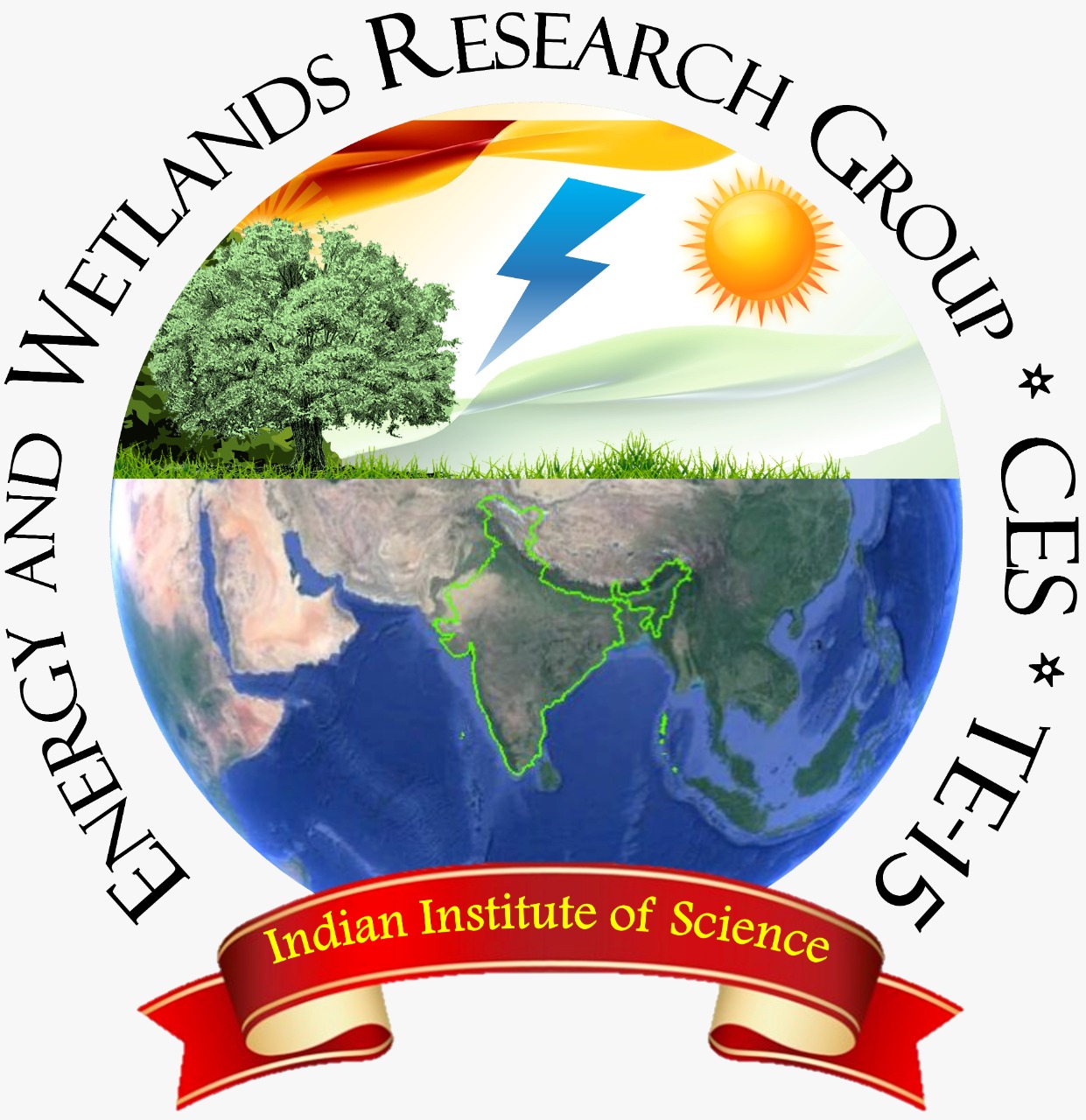 |
Carbon Footprint of Karnataka:
Accounting of Sources and Sinks |
 |
T.V. Ramachandra, Bharath Setturu
1 Energy and Wetlands Research Group, Centre for Ecological Sciences [CES], 2 Centre for Sustainable Technologies (astra)
3 Centre for infrastructure, Sustainable Transportation and Urban Planning [CiSTUP]
Indian Institute of Science, Bangalore – 560012, India.
*Corresponding author: tvr@iisc.ac.in
|
References
- Abbas SZ, Kousar A, Razzaq S et al. (2018) Energy management in South Asia. Energy Strateg Rev 21:25–34. https://doi.org/10.1016/j.esr.2018.04.004
- Ali MB, Saidur R, Hossain MS (2011) A review on emission analysis in cement industries. Renew Sustain Energy Rev 15:2252–2261. https://doi.org/10.1016/j.rser.2011.02.014
- Batjes NH, Dijkshoorn JA (1999) Carbon and nitrogen stocks in the soils of the Amazon Region. Geoderma 89:273–286. https://doi.org/10.1016/S0016-7061(98)00086-X
- Bharath S, Rajan KS, Ramachandra TV (2013) Land Surface Temperature Responses to Land Use Land Cover Dynamics. Geoinfor Geostat an Overv 1. https://doi.org/10.4172/2327-4581. 1000112
- Blunden J, Arndt DS (2017) State of the Climate in 2016. Bull Am Meteorol Soc 98:Si-S280. https://doi.org/https://doi.org/10.1175/2017BAMSStateoftheClimate.1
- Chhabra A, Palria S, Dadhwal VK (2003) Soil organic carbon pool in Indian forests. for Ecol Manage 173:187–199. https://doi.org/10.1016/S0378-1127(02)00016-6
- Dadhwal VK, Singh S, Patil P (2009) Assessment of phytomass carbon pools in forest ecosystems in India. NNRMS Bull 41–57
- Devagiri GM, Money S, Singh S et al (2013) Assessment of above ground biomass and carbon pool in different vegetation types of south western part of Karnataka, India using spectral modeling. Trop Ecol 54:149–165
- Dixit AK, Birthal PS (2016) Greenhouse gases emission from livestock production system of India: An actual consumption approach. Indian J Anim Sci 86:1331–1336
- Van Do T, Trung PD, Yamamoto M et al (2018) Aboveground biomass increment and stand dynamics in tropical evergreen broadleaved forest. J Sustain for 37:1–14. https://doi.org/10. 1080/10549811.2017.1375959
- Eggleston S, Buendia L, Miwa K et al (2006) 2006 IPCC Guidelines for National Greenhouse Gas Inventories. Institute for Global Environmental Strategies Hayama, Japan
- EMPRI (2012) Karnataka State Action Plan On Climate Change, 1st Assessment. TERI, NewDelhi, Bengaluru
- Gallardo M, Gómez I, Vilar L et al (2016) Impacts of future land use/land cover on wildfire occurrence in the Madrid region (Spain). Reg Environ Chang 16:1047–1061. https://doi.org/ 10.1007/s10113-015-0819-9
- Ghazoul J, Butler RA, Mateo-Vega J, Koh LP (2010) REDD: a reckoning of environment and development implications. Trends Ecol Evol 25:396–402. https://doi.org/10.1016/j.tree.2010. 03.005
- Ghose MK, Paul R, Banerjee SK (2004) Assessment of the impacts of vehicular emissions on urban air quality and its management in Indian context: The case of Kolkata (Calcutta). Environ Sci Policy 7:345–351. https://doi.org/10.1016/j.envsci.2004.05.004
- Gupta D, Singh SK (2012) Greenhouse Gas Emissions from Wastewater Treatment Plants. J Water Sustain 2:131–139
- Gupta PK, Sahai A, Singh N et al (2004) Residue burning in rice-wheat cropping system: causes and implications. Curr Sci 87:1713–1717
- Guthrie G, Kumareswaran D (2009) Carbon Subsidies, Taxes and Optimal Forest Management. Environ Resour Econ 43:275–293. https://doi.org/10.1007/s10640-008-9238-4
- Houghton RA, Hackler JL (1999) Emissions of carbon from forestry and land-use change in tropical Asia. Glob Chang Biol 5:481–492. https://doi.org/10.1046/j.1365-2486.1999.00244.x
- Indu M, Gupta M, Tomar S et al (2013) Carbon Sequestration Potential of Agroforestry Systems in India. J Earth Sci Clim Change 04:1–7. https://doi.org/10.4172/2157-7617.1000131
- Jose VS, Sejian V, Bagath M et al (2016) Modeling of Greenhouse Gas Emission from Livestock. Front Environ Sci 4:1–10. https://doi.org/10.3389/fenvs.2016.00027
- Kaul M, Mohren GMJ, Dadhwal VK (2010) Carbon storage and sequestration potential of selected tree species in India. Mitig Adapt Strateg Glob Chang 15:489–510. https://doi.org/10. 1007/s11027-010-9230-5
- Köhl M, Frühwald A (2009) Permanent Wood Sequestration: No Solution to the Global Carbon Dioxide Problem. Chemsuschem 2:609–613. https://doi.org/10.1002/cssc.200800240
- Lal R (2004) Soil carbon sequestration impacts on global climate change and food security. Science (80- ) 304:1623–1627. https://doi.org/https://doi.org/10.1126/science.1097396
- Lal R (1999) Soil management and restoration for C sequestration to mitigate the accelerated greenhouse effect. Prog Environ Sci 1:307–326
- Le Quéré C, Andrew RM, Friedlingstein P et al (2018) Global Carbon Budget 2018. Earth Syst Sci Data 10:2141–2194. https://doi.org/10.5194/essd-10-2141-2018
- Leach M, Scoones I (2013) Carbon forestry in West Africa: The politics of models, measures and verification processes. Glob Environ Chang 23:957–967. https://doi.org/10.1016/j.gloenv cha.2013.07.008
- Lillesand T, Kiefer RW, Chipman J (2015) Remote sensing and image interpretation. John Wiley & Sons
- Liu X, Bae J (2018) Urbanization and industrialization impact of CO2 emissions in China. J Clean Prod 172:178–186. https://doi.org/10.1016/j.jclepro.2017.10.156
- Mundaca G (2017) How much can CO2 emissions be reduced if fossil fuel subsidies are removed? Energy Econ 64:91–104. https://doi.org/10.1016/j.eneco.2017.03.014
- Nair PKR, Nair VD, Kumar BM, Haile SG (2009) Soil carbon sequestration in tropical agro- forestry systems: a feasibility appraisal. Environ Sci Policy 12:1099–1111. https://doi.org/10. 1016/j.envsci.2009.01.010
- Ni Y, Eskeland GS, Giske J, Hansen JP (2016) The global potential for carbon capture and storage from forestry. Carbon Balance Manag 11. https://doi.org/10.1186/s13021-016-0044-y
- Pachauri RK, Reisinger A (2007) Contribution of Working Groups I, II and III to the Fourth Assessment Report of the Intergovernmental Panel on Climate Change
- Pan Y, Birdsey RA, Fang J, et al (2011) A large and persistent carbon sink in the world’s forests. Science (80- ) 333:988–93. https://doi.org/https://doi.org/10.1126/science.1201609
- Pandey R, Rawat GS, Kishwan J (2011) Changes in Distribution of Carbon in Various Forest Types of India from 1995–2005 Changements dans la Distribution du Carbone dans Différents Types de Forêts en Inde. Silva Lusit 19:41–54
- Pongratz J, Reick CH, Houghton RA, House JI (2014) Terminology as a key uncertainty in net land use and land cover change carbon flux estimates. Earth Syst Dyn 5:177–195. https://doi. org/10.5194/esd-5-177-2014
- Rai SN, Proctor J (1986) Ecological Studies on Four Rainforests in Karnataka, India. J Ecol 74:439–454
- Rajan K, Natarajan A, Anil Kumar KS et al (2010) Soil organic carbon - the most reliable indicator for monitoring land degradation by soil erosion. Curr Sci 99:823–827
- Ramachandra TV, Aithal BH, Sreejith K (2015) GHG footprint of major cities in India. Renew Sustain Energy Rev 44:473–495. https://doi.org/10.1016/j.rser.2014.12.036
- Ramachandra TV, Bharath S (2019a) Global Warming Mitigation Through Carbon Sequestra- tions in the Central Western Ghats. Remote Sens Earth Syst Sci 2:39–63. https://doi.org/10. 1007/s41976-019-0010-z
- Ramachandra TV, Bharath S, Gupta N (2018a) Modelling landscape dynamics with LST in protected areas of Western Ghats, Karnataka. J. Environ. Manage. 1253–1262
- Ramachandra TV, Bharath S, Vinay S (2019) Visualisation of impacts due to the proposed developmental projects in the ecologically fragile regions- Kodagu district. Karnataka. Prog Disaster Sci 3:100038. https://doi.org/10.1016/j.pdisas.2019.100038
- Ramachandra TV, Hegde G, Bharath S, Krishnadas G (2014) Bioenergy: A sustainable energy option for rural india. Adv for Lett 3:1–15
- Ramachandra TV, Shwetmala, (2009) Emissions from India’s transport sector: Statewise synthesis. Atmos Environ 43:5510–5517. https://doi.org/10.1016/j.atmosenv.2009.07.015
- Ramachandra TV, Aithal BH, Kulkarni G, Han SS (2018) Municipal solid waste: Generation, composition and GHG emissions in Bangalore, India. Renew Sustain Energy Rev 82:1122– 1136. https://doi.org/10.1016/j.rser.2017.09.085
- Ramachandra TV, Bharath S (2019b) Carbon Sequestration Potential of the Forest Ecosystems in the Western Ghats, a Global Biodiversity Hotspot. Nat Resour Res 29:2753–2771. https:// doi.org/10.1007/s11053-019-09588-0
- Ramachandra TV, Joshi NV, Subramanian DK (2000) Present and prospective role of bioenergy in regional energy system. Renew Sustain Energy Rev 4:375–430. https://doi.org/10.1016/ S1364-0321(00)00002-2
- Ramachandra TV, Subramanian DK, Joshi NV et al (2000) Domestic energy consumption patterns in Uttara Kannada District, Karnataka State, India. Energy Convers Manag 41:775– 831. https://doi.org/10.1016/S0196-8904(99)00151-X
- Ramachandra TV, Bharath S (2018) Geoinformatics based Valuation of Forest Landscape Dynamics in Central Western Ghats, India. J Remote Sens GIS 07:1–8. https://doi.org/10. 4172/2469-4134.1000227
- Ramachandra TV, Chandran MDS, Harish BR, et al (2010) Biodiversity, Ecology and Socio Economic Aspects of Gundia River Basin in the Context of Proposed Mega Hydro Electric Power Project, CES Technical Report 122. Bengaluru
- Ramachandra TV, Shwetmala (2012) Decentralised carbon footprint analysis for opting climate change mitigation strategies in India. https://doi.org/https://doi.org/10.1016/j.rser.2012.05.035
- Randerson JT, van der Werf GR, Collatz GJ et al (2005) Fire emissions from C3 and C4 vegetation and their influence on interannual variability of atmospheric CO2 and δ13CO2. Global Biogeochem Cycles 19:1–13. https://doi.org/10.1029/2004GB002366
- Rao G, Krishnakumar G, Sumesh Dudani N et al (2013) Vegetation Changes along Altitudinal Gradients in Human Disturbed Forests of Uttara Kannada, Central Western Ghats. J Biodivers 4:61–68
- Ravindranath NH, Ostwald M (2008) Carbon inventory methods: a handbook for greenhouse gas inventory, carbon mitigation and roundwood production projects. Advances in Global Change Research. Carbon Invent methods a Handb Greenh gas Invent carbon Mitig roundwood Prod Proj Adv Glob Chang Res 237–270. https://doi.org/https://doi.org/10.1007/978-1-4020- 6547-7_10
- Ravindranath NH, Somashekhar BS, Gadgil M (1997) Carbon flow in Indian forests. Clim Change 35:297–320. https://doi.org/10.1023/A:1005303405404
- Scharlemann JPW, Tanner EVJ, Hiederer R, Kapos V (2014) Global soil carbon: Understanding and managing the largest terrestrial carbon pool. Carbon Manag 5:81–91. https://doi.org/10. 4155/cmt.13.77
- Sheikh MA, Kumar M, Bussman RW, Todaria NP (2011) Forest carbon stocks and fluxes in physiographic zones of India. Carbon Balance Manag 6:15. https://doi.org/10.1186/1750- 0680-6-15
- Singh A, Gangopadhyay S, Nanda PK et al (2008) Trends of greenhouse gas emissions from the road transport sector in India. Sci Total Environ 390:124–131. https://doi.org/10.1016/j.sci totenv.2007.09.027
- Singh P, Kansal A (2018) Energy and GHG accounting for wastewater infrastructure. Resour Conserv Recycl 128:499–507. https://doi.org/10.1016/j.resconrec.2016.07.014
- Singhal KK, Mohini M, Jha AK, Gupta PK (2005) Methane emission estimates from enteric fermentation in Indian livestock: Dry matter intake approach. Curr Sci 88:119–127
- Sun J, Peng H, Chen J et al (2016) An estimation of CO2 emission via agricultural crop residue open field burning in China from 1996 to 2013. J Clean Prod 112:2625–2631. https://doi.org/ 10.1016/j.jclepro.2015.09.112
- Swamy HR (1992) Organic productivity, nutrient cycling and small watershed hydrology of natural forests and monoculture plantations in Chikmagalur District. Karnataka, John Wiley and Sons Inc, New York, NY (United States)
- Yu S, Wei YM, Guo H, Ding L (2014) Carbon emission coefficient measurement of the coal-to- power energy chain in China. Appl Energy 114:290–300. https://doi.org/10.1016/j.apenergy. 2013.09.062
- Zhang B, Tian H, Ren W et al (2016) Methane emissions from global rice fields: Magnitude, spatiotemporal patterns, and environmental controls. Global Biogeochem Cycles 30:1246– 1263. https://doi.org/10.1002/2016GB005381
|
|
Citation: Ramachandra T.V., Bharath S. (2021) Carbon Footprint
of Karnataka: Accounting of Sources and Sinks. In: Muthu S.S. (eds) Carbon
Footprint Case Studies. Environmental Footprints and Eco-design of Products and
Processes. Springer, Singapore. https://doi.org/10.1007/978-981-15-9577-6_3
| * Corresponding Author : |
| |
Dr. T.V. Ramachandra
Energy & Wetlands Research Group, Centre for Ecological Sciences, Indian Institute of Science, Bangalore – 560 012, India.
Tel : 91-80-22933503 / 22933099,
Fax : 91-80-23601428 / 23600085 / 23600683 [CES-TVR]
E-mail : tvr@iisc.ac.in, envis.ces@iisc.sc.in, Web : http://wgbis.ces.iisc.ac.in/energy, http://ces.iisc.ac.in/grass |
|